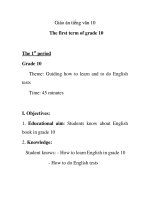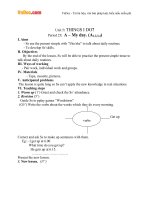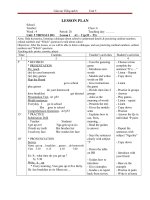Giáo án tiếng anh 10: UNIT 5: Period: I. Objectives: 2 ppt
Bạn đang xem bản rút gọn của tài liệu. Xem và tải ngay bản đầy đủ của tài liệu tại đây (93.13 KB, 33 trang )
G
G
i
i
á
á
o
o
á
á
n
n
t
t
i
i
ế
ế
n
n
g
g
v
v
ă
ă
n
n
1
1
0
0
UNIT 5: TECHNOLOGY AND YOU
Period: B: Speaking
I. Objectives:
1. Educational aims: Students should appreciate the
modern devices that help make our life
comfortable and should know how to use them
properly and economically
2. Knowledge:- General knowledge: Students learn
about how present and future devices and equipment
may change our life styles
- Language: Asking for and giving information
about the uses of modern inventions
- New words: Words related to modern and
equipment
3. Skill: Talking about the uses of modern
technology
II. Method: Integrated, mainly communicative
III. Teaching aids: Real objects and pictures showing
various modern devices; an air conditioner, a
computer, a fax machine, an electric cooker etc.
IV. Procedures:
Tim
e
Teacher’s activities Students’ activities
Warm-up: (4 minutes)
- Show a modern device (or a
picture of a modern device)
and ask students the
questions:
1. What’s this?
2. What is it used for?
- Listen to the teacher
-
Look at the things
teacher shows and
answer the questions:
1. It’s a fax machine
2. It’s used to send
and receive letters
- Ask students to name some
modern devices they know
Pre-speaking: (5 minutes)
- Ask students some
questions:
1. What is used to listen to
music and news?
2. What is used to wash the
clothes?
While-speaking: (24
minutes)
Task 1 (8 minutes):
- Ask students to ask and
answer questions about the
uses of modern inventions
- Let them work in pairs
- Walk round, listen to the
quickly
- Computer, radio,
T.V, electric cooker,
air conditioner
1. Radio
2. A washing
machine
- Look at the books
- Listen to the teacher
- Do task 1 in pairs
A: Can you tell me
what a radio is used
for?
B: It is used to listen
to music and news
students
- Help students if necessary
Task 2 (8 minutes):
- Ask students to do task 2
- Introduce students how to
do task 2
- Let them work in pairs
- Walk round and help
students if necessary
C: Can you tell me
what a T.V is
used
for?
D: It is used to watch
news
- Look at task 2,
listen to the teacher
- Work in pairs
Keys:
1.store; 2.transmit; 3.
process; 4.send;
5.hold; 6.make;
7.send; 8. receive;
9.design
Task 3 (8 minutes):
- Ask students to look at the
ideas in task 2, then rank
them in order of importance
and explain why
- Let them work in pairs
- Walk round, listen, check
and help students if they
can’t do
Post-speaking: (9 minutes)
Task 4:
- Ask students to talk about
the uses of information
- Listen to the teacher
- Work in pairs
A: In what way is
information
technology the most
useful to our lives?
B: I think…
A: Why do you think
so?
B: Because…
- Look at Task 4
teachnology, use the
information above
- Let them work in groups
- Check and help students
- Call some students to talk
to each other then mark them
Homework: (3 minutes)
- Ask students to do part
Speaking: exercise 1, 2 in
workbook and prepare part
Listening at home
- Work in groups
A: Do you think
information
technology is very
important to our
lives? why?
B: Yes. Because it
can help us store very
large a
mounts of
information transmit
information quickly
-
Listen to the teacher
and write down
UNIT 5: TECHNOLOGY AND YOU
Period : C: Listening
I. Objectives:
1. Educational aim: Students should know
experience of learning how to use a
computer
2. Knowledge:
- General knowledge: Students know how to use
a computer
- Language
- New words: Words related to using a computer
3. Skill: Listening for gist and for specific
information
II. Method: Integrated, mainly communicative
III. Teaching aids: Student’s book, tape, cassette
player, some pictures of the modern
devices
IV. Procedures:
Ti
me
Teacher’s activities Students’
activities
Warm-up: (4 minutes)
- Show the picture about a radio
and ask students to say how to
do when you use a radio
- Listen to students and repair
their mistakes
Pre-listening: (9 minutes)
- Look at the
picture
- Listen to the
teacher
- Speak about
what we’ll do
when using a
radio
A: First plug
into socket then
-
Ask students to open the books
and look at the part “Before you
read”
- Ask students some questions:
1. How many electrical
appliances are there on the
table?
2. What are they?
* Ask students to ask and
answer how often they use each
of the items below and put a tick
( ) in the right column
- Let they work in pairs
turn it on…
- Listen to the
teacher, look at
the book
- Answer the
questions:
1. There are….
2. They are…
- Work in pairs
A: How often do
you use a radio?
B: very often
A: How often do
you use a cell
* Ask students to listen and
repeat the words:
worried, memory, refused
excuse, VDU (visual display
unit) headache
- Listen and correct mistakes
While-listening: (20 minutes)
Task 1 (10 minutes):
- Ask students to look at Task 1
- Ask them to read the
statements carefully and try to
understand them
- Ask students to listen to the
tapescript and decide whether
the statements are true or false
- Read or turn on the tapescript
phone?
B: sometimes
……………….
- Listen and
repeat the words
- Look at the
task 1 and listen
to the teacher
- Read the
statements and
try to understand
them
- Listen to the
tapescript
twice
- Ask students to give their
answers
Task 2 (10 minutes):
- Ask students to read the
passage carefully
- Ask students to listen to the
old man’s story again and write
in the missing words
- Read or turn on the tapescript
again once or twice
- Help students give the correct
answers
- Decide
whether the
statements are T
or F
- Give correct
answers:
1.F – 2.T – 3.T –
4.F – 5.F – 6.F
- Look at task 2,
listen to the
teacher
- Read the
passage
- Listen to the
tapescript
- Give the
correct answers
Post-listening: (10 minutes)
- Ask students to listen to the
man’s talk again then retell his
story, beginning the story with
the following sentence: The
story is about an old man who
doesn’t hnow how to use the
computer…
- Read or turn on the tapescript
again
- Let them work in groups
- Call some students to retell the
story
- Help students and correct
mistakes
Homework: (2minutes)
1. invented–
2.still–3.refused
– 4. excuse–5.
anything
- Listen to the
teacher
- Listen to the
tapescript again
- Try to retell the
story
- Work in groups
- The students
are called to
stand up and
retell the story
- Ask students to rewrite the old
man’s story and retell
- Ask students to prepare the
part Writing at home
about an old
man who
doesn’t know
how to use the
computer…
- Listen to the
teacher and
write down the
task
The 28
th
period
Date:
Grade 10
Theme: Technology and you
Unit 5
Writing
Time: 45 minutes
I. Objectives:
1. Educational aim: Students should appreciate
public telephones; televisions that
help make our life comfortable and
should know how to use them
properly and economically
2. Knowledge:
- General knowledge: - Students learn how to use
public telephones, televisions
- Students learn how to write a set of
instructions
- Language: Sequence connectors and imperative
verb form often used in a set of instructions
- New words: Words related to public telephones,
televisions and remote controls
3. Skill: Writing a set of instructions
II. Method: Integrated, mainly communicative
III. Teaching aids: Student’s book, real objects and
pictures showing a public telephone, a
card phone, a remote control, a
television
IV. Procedures:
Teacher’s activities Students’
activities
Notes
Warm-up: (4 minutes)
- Ask students to close the
book
- Ask students to listen and
- Listen to the
teacher and
answer the
answer the questions:
1. Have you ever used a
public telephone?
2. Is it easy or difficult to
use it?
3. Can you show me how
to use it?
- It students cannot answer
the question or answer
them incorrectly, ask
students to open their
books and introduce the set
of instructions on how to
use a public telephone
Pre-writing: (8 minutes)
Task 1:
questions:
1. Yes, I have/
No, I have not
2. It is easy/
difficult
( Answer freely)
- Read task 1
carefully
- Ask students to read
carefully the set of
instructions on how to use
a public telephone
- Let them work in pairs
and try to understand its
meaning
- Explain meaning of
words and phrases students
haven’t known
- Show a phone-card and
ask students:
1. What’s this?
2. What’s it used for?
3. What are the steps in
using a public telephone?
- Discuss its
meaning
- Work in pairs
- Ask the
teacher some
new words or
phrases
- Answer the
questions:
1. It is a phone
card.
2. It is used to
make a call
3. They are first,
lift… next,
insert…
4. What should you do if
you want to get help?
While-writing: (18
minutes)
Task 2 (6 minutes):
- Introduce how to do task
2
- Let them work in pairs
- Ask students to give the
answers
- Walk round and help
students
4. To obtain
help, dial 116
- Look at the
students’ book
- Listen to the
teacher
- Do task 2 in
pairs
- Give the
answers:
+ Connectors:
first, then, next,
until
+ Imperalive
Task 3 (12 minutes):
- Ask students to look at
task 3
- Introduce how to do it
- Let them work in groups
- Help students to answer
the questions in task 3
- Walk round and repair
students’ mistakes
form of the
verbs: lift,
insert, press,
wait
- Look at task 3,
listen to the
teacher
- Do task 3 in
groups
- Give the
answers:
1. If we want to
operate a T.V
with a remote
control, we have
to make sure
Post-writing: (12
minutes)
Task 4:
- Ask students to look at
task 4
- Ask students to write a set
of instructions on how to
operate a T.V with a
remote control
- Let them work in groups
that the card is
plugged in and
the main is
turned on
2. Press the
power button
3. Press the
programme
button
4. Press 1, 2, 3,
4…
5. Press the
volume button
up and down
6. Press the
mute button
- Walk round and help
students if they want
- Ask some students to
stand up and read loudly
their sets of instructions
- Correct mistakes
- Do task 4 in
groups
- Some students
stand up to read
loudly the set of
instructions
A: If you want
to operate a T.V
with a remote
control, you
must make sure
that the card is
plugged in and
the main is
turned on. First,
press the power
Homework: (2minutes)
- Ask students to rewrite
the set of instructions in the
notebook, do part writing
in work book and prepare
new lesson at home
button to turn
on the T.V.
Next, select the
channel by
pressing number
1, 2, 3 … then
press program
button to select
the program you
like. Finally,
press the
volume button
up and down to
select the
volume and if
you want to turn
off, press the
power button
again.
- Listen to the
teacher and
write down
The 29
th
period
Date:
Grade 10
Theme: Technology and you
Unit 5
Language focus
Time: 45 minutes
I. Objectives:
1. Educational aim: Students should know how to
write full sentences to describe the
things have been done
2. Knowledge:
- General knowledge: Students learn how to write
long-full sentences
- Language: The present perfect and present perfect
passive for talking about the things have
been done
- New words: Words related to pronunciation / / - /
u: /
3. Skill: - Pronunciation : / / - / u: /
- Grammar and vocabulary: + The
present perfect
+ The present perfect
passive
+ Relative pronouns
II. Method: Integrated, mainly communicative
III. Teaching aids: Student’s book, tape, cassette
player
IV. Procedures:
Teacher’s activities Students’
activities
Notes
Warm-up: (4 minutes)
- Ask students to close their
books
- Write on the board two
sentences:
1. Sue often goes to school
on foot.
2. Look at your shoes, take
- Look at the
board and listen
to the teacher
- Read loudly
the sentences









